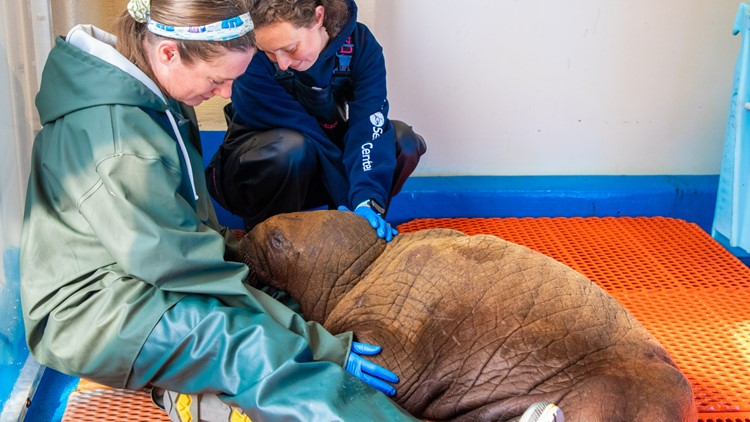NORTH SLOPE, Alaska — A baby walrus was found lost and alone along the North Slope of Alaska with little hope for survival. Now, in a rare and "exceptional" rescue attempt, he's being raised and nursed – with 24/7 cuddles.
The Pacific walrus calf, believed to be roughly a month old, arrived at the Alaska SeaLife Center on Aug. 1 after being discovered by workers on the state's North Slope. He was just 4 miles inland from the Beaufort Sea, which the center says is a "highly unusual location" for his species. Pacific walruses typically live in the ocean or near the western coastline, the group said, and it's unknown how the young animal made it to the location where he was found.
But while questions abound, one thing was clear – he needed help immediately.
"Walrus calves depend on maternal care for their first two years of life," the center said, "and with no adults in the vicinity, it was apparent that the wayward calf would not survive long without intervention."
So the center took him in and found that he was suffering from malnutrition, dehydration, a cloudy eye and potentially had an infection. Because of how critical it is for young walruses to be close to their mothers in their first 2 years of life, the center said it deployed "round-the-clock 'cuddling'" to help him stay calm and grow to be healthy.
On Sunday, the center determined that the calf, originally estimated to weigh 200 pounds, is roughly 140 pounds. He's continuing to eat well and "remains alert," they said.
Getting a walrus for a patient is a rare event for the Alaska SeaLife Center. The organization said this calf marks the first walrus patient in four years, and is only the tenth to be admitted in their 25-year history.
The center's wildlife response curator Jane Belovarac said the team is "lucky" that the young walrus' first night went well.
"It isn't often that we're able to admit a walrus calf, but every time we do, we learn more about the species and how to care for them," Belovarac said.
According to the Marine Mammal Commission, walruses tend to migrate into the Beaufort Sea – where this calf was found – during years with low amounts of sea ice, which the animals rely on to be able to rest. Without rampant sea ice, some adult females and juvenile walruses are also known to rely on coastal haulouts during the summer feeding season, which is when thousands of the animals have to swim to land and will congregate in a large group. But haulouts are known to be incredibly dangerous – especially for calves.
"With declining ice, commutes to shore can be more than 100 miles," the World Wildlife Fund says. "Often, young calves do not survive the full journey. If they do make it to land, walruses are already fatigued by their travel, and in these locations, nearby food sources may be quickly exhausted. In addition, as walrus are easily spooked—by humans, vehicles, polar bears, or even small animals—they can trample one another in a stampede to the sea. Tragically, many walruses, particularly young calves, die in these stampedes."
As global temperatures continue to warm and sea ice melts, the commission says it's likely that the species will also decline, "although the magnitude of the predicted decline is unknown."



